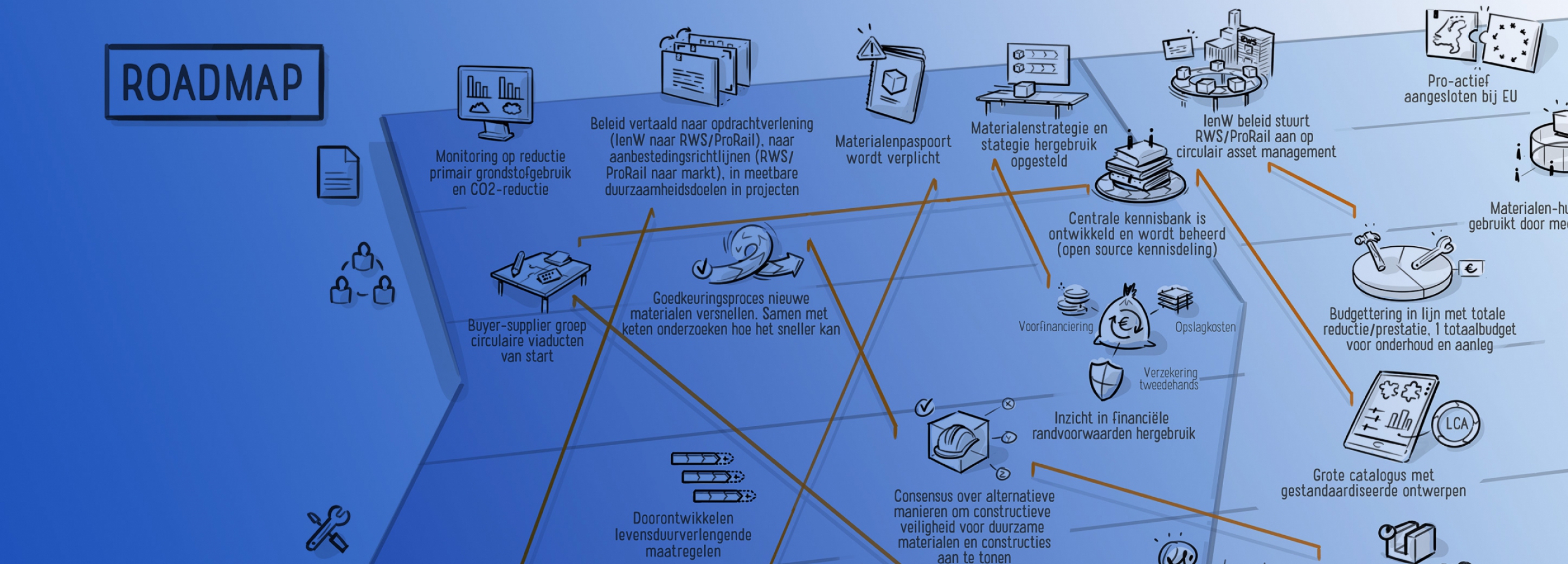By 2030, all government infrastructure projects climate neutral and circular: we helped Rijkswaterstaat to envision their transition.
Rijkswaterstaat wants to be fully circular by 2030: no more CO2 emissions, close the primary raw material cycles and reuse and recycle materials. The focus is on the areas with the greatest climate impact. To get there, ‘transition paths’ have been drawn up for the four areas with the most CO2 emissions.
One of these is the Transition Path for ‘Kunstwerken’ (by that we mean objects like bridges, locks, tunnels, viaducts), where a lot can be gained in the production and use of materials such as concrete and steel. A lot of different parties are involved in this: governments, institutions and market parties. How do you start such a big change with so many stakeholders?
Together we developed a roadmap with the most realistic route to 2030.

Multi-stakeholder approach: working together on change
Rijkswaterstaat invited everyone to contribute ideas, and the enthusiastic market parties joined in. Together, these pioneers and the best experts form an ‘innovation ecosystem’. A great start of course, but even if everyone is willing and feels the need for change, very large long-term goals sometimes seem like a bridge too far.
How do you make the transition to sustainable design, construction and maintenance? Of bridges, sluices, railway underpasses, tunnels and road furniture? With so many parties? Such a major change can cause paralysis or resistance for those involved, because where on earth do you start? It’s so big! An overview and a step-by-step plan are needed.

A shared vision and commitment are essential
First of all, a shared vision is needed. Shared by all parties involved, with everyone in the chain: clients, market parties and knowledge institutions. This requires collecting input on a large scale, defining milestones, zooming out and connecting with each other, prioritizing actions and getting commitment from all parties.
In a process of several months and several sessions, we jointly developed a vision, identified the most important activities and intermediate milestones. Clarity is created by analyzing and organizing all components together with all stakeholders. Then we placed the goals on a timeline. Who exactly will do what and when, is made clear and arranged within the roadmap.


The road to a circular approach
The vision? Most CO2 emissions are caused during the transport and production of materials. That is why the most climate-neutral objects are the ones who do not need to be replaced. That means they need to be well maintained. And if parts do need to be replaced? A futuristic bridge in 2050 is completely repaired onsite, with standardized parts.
Materials hubs across the country store parts and create new parts. And a newly built bridge in the near future (say: 2030) is also modular. Everything comes down to standardization and as little transport as possible: this makes it possible to reuse parts in new buildings.

First a goal, then a roadmap
A clear long-term goal provides clarity and peace of mind: everyone knows what the direction is. As soon as all parties know what the goal is (completely climate neutral in 2030: what does that mean?), it is necessary to coordinate how you are going to get there. It is necessary to break a long-term goal into manageable chunks and realistic milestones, so that people can realize that goal step by step.
In short, strategic planning is an essential part of implementing a vision. A roadmap is used to indicate direction and to set out a strategy over time. A roadmap provides a clear overview of all long and short term objectives, strategic tasks, milestones and dependencies and helps to achieve goals. This makes it simpler, understandable and clear.

A shared image gives direction
The visualizations here are certainly not the end product, but they are powerful tools for tackling a complex subject with many people. Maya Sule, Rijkswaterstaat’s program manager, has now also seen our visual in presentations by fellow governments and noticed that the project with Flatland has provided them a lot of guidance.
“Flatland’s visuals have helped enormously in defining the roadmap. The common image provides a good basis for the conversation about how we can achieve this vision together,” says Maya. The roadmap and visualizations provide clarity and direction, so that everyone takes action.
This shared image provides a good basis for the discussion about how we can achieve this future together.
Maya Sule Programmemanager Rijkswaterstaat
Michelle Geerlings
How we can help your organization with transition? Send Michelle a message!
Email Michelle
Other Flatland Cases

Energy Top Sector - Overlapping innovation tasks visible
Collaboration requires a shared story! By visualizing, we made the common ground and language for innovation challenges clear.

ProRail - Environment, assets and importance clarified
For this complex operational organization, we clarified all activities, environments and assets. Drawings put departments on the map!

Province of Noord-Holland - Digitization strategy in one week
How do you develop a strategy for a province with more than 125 experts? This can be done in one week, completely virtually!

